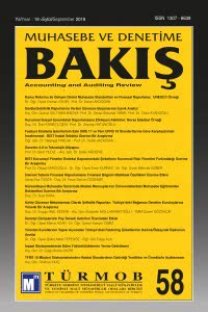ÜRÜNLERİN YAŞAM DÖNGÜSÜ MALİYETLERİNİN İŞLETME KARARLARINA ETKİLERİNİN ÇEVRESELYAKLAŞIMLA DEĞERLENDİRİLMESİ
Çevrenin korunmasının ve üretilen ürünlerin çevredeki olası olumsuz etkilerinin öneminin giderek daha iyi farkedilmesi, söz konusu olumsuz etkileri azaltabilecek yöntemlerin geliştirilmesini özendirmiştir. Bu amaçla geliştirilen tekniklerden bir tanesi de Yaşam Döngüsü Değerlendirmesidir.Ürünlerin yaşam döngüsü boyunca çevresel etkilerinden ortaya çıkan doğrudan ve dolaylı maliyetler, ürünlerinçevresel maliyetlerinin de göz önüne alınmasını gerektirmektedir. Bununla, ürünlerin çevresel maliyetlerini toplam maliyetine eklemek, ürünlerin çevresel maliyetlerini yaşam döngüsü değerlendirme pratiği içine dahil ederek, yaşam döneminin her devresinde çevre dostu alternatiflerinin çeşitlendirilmesine çalışmak ve böylece toplam maliyetleri azaltmak hedeflenmektedir. Bu çalışmada, çevresel kararların alınmasında teorik varsayımları veyaşam döngüsü maliyetlerini göz önüne almanın pratik yararları tartışılmaktadır
Anahtar Kelimeler:
Yaşam Döngüsü Değerlendirmesi, Yaşam Döngüsü Maliyetleme, Çevresel Yaşam Döngüsü Maliyetleme, Çevre Yönetimi, Karar Destek Araçları.
THE EFFECTS OF THE LIFE CYCLE COSTS OF THE PRODUCTS TO BUSINESS DECISIONS ON ENVİRONMENTAL APPROACH
Better perception of the importance of the environmental protection and the probable negative effects of the finished products by the time, promoted the developing of decreasing methods of such negative effects. One ofthe techniques developed for this purpose is Life Cycle Assessment.Environmental costs are both the direct and indirect costs of the environmental impact caused by the product inits entire life cycle. The objective of these life cycle environmental costs is to include environmental costs intothe total costs of the products. The purpose of this study is to discuss theoretical assumptions and the practicalusefulness of the life cycle costs approach in making environmental decisions
Keywords:
Life Cycle Assessment, Life Cycle Costing, Environmental Life Cycle Costing, Environmental Management, Decision Support Tools.,
___
- Banerjee, Subhabrata Bobby, “Corporate Environmental Strategies and Actions”, Management Decision, Vol.39 No.1, 2001.
- Bansal Pratima ve Bogner, William C., “Deciding on ISO 14001: Economics, Institutions, and Context”, Long Range Planning, Vol.35, 2002.
- Değirmendereli, Ali, Mali Yükümlülüklerin Çevresel Amaçlar İçin Kullanılması ve Ekolojik Vergi Reformu, Do- kuz Eylül Üniversitesi Sos. Bil. Ens. Yayımlanmamış Doktora Tezi, 2002.
- Dunk, Alan S., “Product Life Cycle Cost Analysis: the Impact of Customer Profiling, Competitive Advantage, and Quality of IS Information”, Management Accounting Research, Vol. 15, 2004.
- EPA, United States Environmental Protection Agency, Design for the Environment: Product Life Cycle De- sign Guidance Manual, Government Institutes, Inc., USA, 1994.
- Ersoy, Mehmet, “Ömre Dayalı Maliyetleme”, Muhasebe Bilim Dünyası Dergisi, Cilt:4, Sayı:2, Haziran 2002.
- Gilpin, Alan, Environmental Impact Assessment, Camridge Universty Pres, 1995.
- Gluch Pernilla ve Baumann, Henrikke, “The Life Cycle Costing (LCC) Approach: A Conceptual Discussion of its Usefulness for Environmental Decision-Making”, Building and Environment, Vol. 39, 2004.
- Gluch, Pernilla, “Cost of Environmental Errors (CEE) A Managerial Environmental Accounting Tool or a Symptom of Managerial Frustration?”, GMI Vol. 31, 2000.
- Hilton, W. Ronald, Maher, W. Michael, Selto, H.Frank, Cost Management: Strategies for Business Decisi- on, International Edition, McGraw-Hill Inc. 2003.
- Horngren, Charles T., Foster, George, Datar, Srikant M., Cost Accounting A Managerial Emphasis, Pren- tice Hall of India Private Limited, New Delhi, 2001. h t t p : / / w w w. a r c e l i k a s . c o m . t r / C u l t u r e s / t r- T R / To p l u m s a l S o r u m l u l u k / C e v r e m i z I c i n / C e v r e c i U r u n l e r / ? M E N U I D = 5 , (02.05.2005).
- Jash, Christine, “The Use Of Environmental Management Accounting (EMA) For Identifying Environmental Costs”, Journal of Cleaner Production, Vol.11, 2003.
- Krause, Martin, “Green Accounting”, Sustainable Development: Promoting Progress or Perpetuating Po- verty?, Edited by Julian Morris Profile Books, London August 2002.
- Kumaran, D. Senthil, Ong, S. K., Tan, Reginald B. G., Nee, A. Y. C., “Environmental Life Cycle Cost Analy- sis of Products”, Environmental Management and Health, Vol. 12, No. 3, 2001.
- Letmathe, Peter ve Balakrishnan, Nagraj, “Production, Manufacturing and Logistics Environmental Conside- rations on the Optimal Product Mix”, European Journal of Operational Research, 2004.
- Sermaye Piyasasında Muhasebe Standartları Hakkında Tebliğ ( Seri XI, No: 25), 15 Kasım 2003, 25290 Sayılı RG Mükerrer Sayısı.
- Sevim, Adnan, “Stratejik Kar Yönetiminde Çağdaş Bir Araç: Ürün Yaşam Seyri Maliyet Sistemi”, Muhasebe Bilim Dünyası Dergisi, Cilt:4, Sayı:1, Mart 2002.
- Tavmergen, İge, “ISO 14000 Çevre Yönetim Sistemleri: Uygulama Aşamaları ve Uygulayanlara Sağladığı Fay- dalar”, Dış Ticaret Dergisi, 1998.
- Tek, Ömer Baybars, Pazarlama İlkeleri Global Yönetimsel Yaklaşım Türkiye Uygulamaları, 8. Baskı, Be- ta, İstanbul, 1999.
- TSE, Çevre Yönetimi-Hayat Boyu Değerlendirme- Prensipler ve Çerçeve (TSE EN ISO 14040), Türk Stan- dartları Enstitüsü, Ankara, 1998.
- Woodward, David, “Life Cycle Costing-Theory, Information Acquision and Aplication”, International Jour- nal of Project Management, 1997.
- ISSN: 1307-6639
- Yayın Aralığı: Yılda 3 Sayı
- Başlangıç: 2000
- Yayıncı: TÜRMOB
